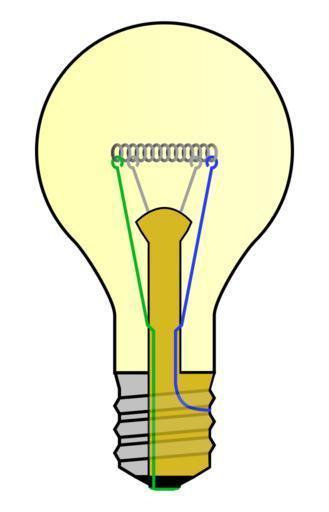
A fused bulb does not glow. Why?
Answer
555.6k+ views
Hint Start by thinking about the construction of the bulb and which part of the bulb’s structure makes the bulb glow. And how does a bulb get fused and what happens when it does get fused?
Complete step by step answer
As explained in the hint section of the question, we will start by checking the construction of the bulb and thinking about which part of the bulb makes it glow.
A diagram of the bulb is shown below:

As we can see, there is a filament in the center of the bulb, and this is the part of the structure of the bulb which is responsible for generating light and making the bulb glow. It is also an element of the circuit of the bulb which actually generates heat in the coil filament of usually tungsten which generates heat along-with light. That is why when you touch a glowing bulb, the bulb is hot if it has been glowing for quite some time.
A bulb can get fused in multiple ways due to multiple reasons, but the most common way is when the coil filament of the bulb breaks. Since it is an integral part of the circuit of the bulb, if it breaks, the circuit gets broken and no current then flows through the circuit. Also, since it is the light generating part of the bulb’s structure, if it breaks, there will be no light generated as it was this party's responsibility alone.
Note Many students answer the question only as “Since the circuit is broken, the bulb does not glow.” But to get full marks, you need to explain the construction of the bulb, mention the part which is responsible for generating light and heat and what happens when the bulb gets fused.
Complete step by step answer
As explained in the hint section of the question, we will start by checking the construction of the bulb and thinking about which part of the bulb makes it glow.
A diagram of the bulb is shown below:

As we can see, there is a filament in the center of the bulb, and this is the part of the structure of the bulb which is responsible for generating light and making the bulb glow. It is also an element of the circuit of the bulb which actually generates heat in the coil filament of usually tungsten which generates heat along-with light. That is why when you touch a glowing bulb, the bulb is hot if it has been glowing for quite some time.
A bulb can get fused in multiple ways due to multiple reasons, but the most common way is when the coil filament of the bulb breaks. Since it is an integral part of the circuit of the bulb, if it breaks, the circuit gets broken and no current then flows through the circuit. Also, since it is the light generating part of the bulb’s structure, if it breaks, there will be no light generated as it was this party's responsibility alone.
Note Many students answer the question only as “Since the circuit is broken, the bulb does not glow.” But to get full marks, you need to explain the construction of the bulb, mention the part which is responsible for generating light and heat and what happens when the bulb gets fused.
Recently Updated Pages
Master Class 12 Business Studies: Engaging Questions & Answers for Success

Master Class 12 Social Science: Engaging Questions & Answers for Success

Master Class 12 English: Engaging Questions & Answers for Success

Master Class 12 Chemistry: Engaging Questions & Answers for Success

Class 12 Question and Answer - Your Ultimate Solutions Guide

Master Class 12 Economics: Engaging Questions & Answers for Success

Trending doubts
What are the major means of transport Explain each class 12 social science CBSE

Which are the Top 10 Largest Countries of the World?

Draw a labelled sketch of the human eye class 12 physics CBSE

How much time does it take to bleed after eating p class 12 biology CBSE

Explain sex determination in humans with line diag class 12 biology CBSE

When was the first election held in India a 194748 class 12 sst CBSE




